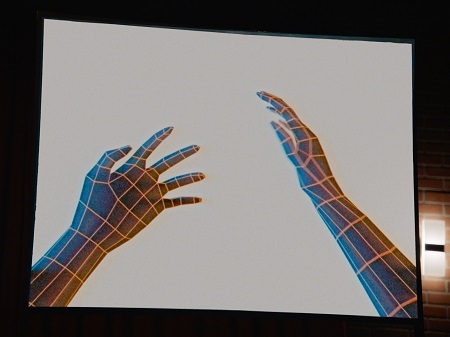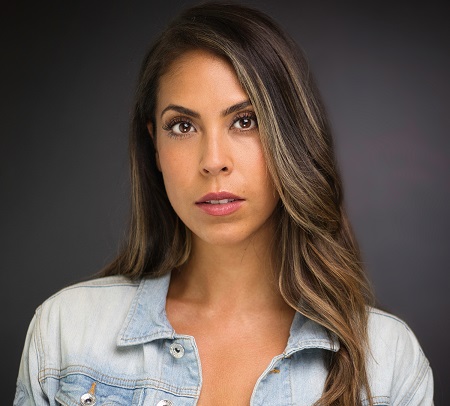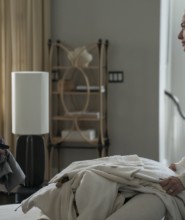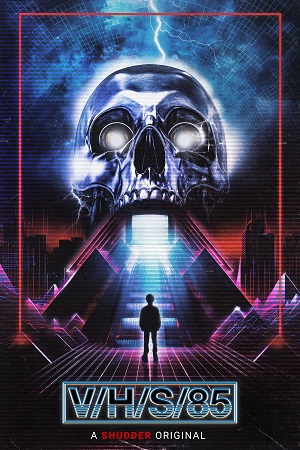
“V/H/S/85” – Interview with Natasha Kermani and Gigi Saul Guerrero
by Sara Michelle Fetters - October 6th, 2023 - Features Interviews
Reality, Fantasy, History, Technology, and Terror Collide
V/H/S/85 Queens Natasha Kermani and Gigi Saul Guerrero on adding their distinctive voices to the iconic horror anthology series
In 2012, a group of talented underground indie filmmakers led by Radio Silence (Matt Bettinelli-Olpin, Tyler Gillett, and Chad Villella), Ti West, Adam Wingard, Simon Barrett, Joe Swanberg, and David Bruckner joined forces to craft the wickedly inventive found-footage horror anthology V/H/S. Over a decade and five sequels (not to mention one spinoff, Kids vs. Aliens) later, the series is stronger than ever, the latest installment V/H/S/85 premiering to enthusiastic reviews on Shudder this October.
While never reaching the stratospheric highs of Gareth Huw Evans and Timo Tjahjanto’s electrifying “Safe Haven” from 2013’s V/H/S 2, this new entry in the series may just be the most consistently entertaining V/H/S effort yet. Featuring six tales of terror from a returning Bruckner, horror veteran Scott Derrickson, Wrong Turn reboot director Mike P. Nelson, Lucky auteur Natasha Kermani, and actor, voice-over specialist, and resourceful filmmaker Gigi Saul Guerrero, there’s not a bad apple in this anthology bunch.
I had the pleasure to sit down with both Kermani and Guerrero to talk about their two films included in V/H/S/85. The following are the edited transcripts of what each of them had to say:
NATASHA KERMANI — “TKNOGD”
A performance artist, Ada Lovelace (Chivonne Michelle), stages a one-woman-show where she calls out the evils of a society diving headfirst into new technologies it barely understands — in this case a new cutting-edge field called “virtual reality” — by trying to communicate with digital gods she doesn’t even believe exist in the first place.
Sara Michelle Fetters: I am going to start off-topic for a moment if that’s all right, because I want to say that Lucky was one of my top 20 films of 2021. I want to congratulate you on that one. It was freaking phenomenal, and it pains me when I see people get mad at it for all the wrong reasons and, of course, the exact wrong reasons you would expect.
Anyhow, great movie. Well done.
Natasha Kermani: Thank you so much. It was a real labor of love, so I love to hear that.
SMF: How do you go from that one to then getting invited to be a part of the V/H/S team? What was that experience like?
NK: It was really cool. I was a fan of V/H/S already. I saw them, the first two, I think in college — at least the first one — and I’m such a fan of the filmmakers. Just the rawness of them all. It was exciting to see this sort of raw, liberated storytelling from these guys who went on and made bigger movies.
Then I saw V/H/S/94 when it came out and I had a relationship with Shudder, of course, after Lucky. So I was having a conversation with David Bruckner, one of the producers, and he just said, “Hey, would you have something you would want to do in the V/H/S world?” He shared the year, 1985, during that conversation.
Off of that, the writer Zoe Cooper and I had a concept that had sort of been floating around in our heads but never really took flight for us. When we sort of recontextualized it in 1985, it started to blossom. These sort of interesting parallels and dialogues with today and technology and all this kind of stuff started brewing, and we’re like, there’s something cool here. We pitched it to the producers, and they liked it, so suddenly we were off making the movie.
SMF: What I love about yours is that it reminded me of when I first got to college at the University of Washington. College is like the first time you go out and you start experiencing people doing performance art and doing these kinds of weird psychological presentations. The whole opening sequence to “TKNOGD” I was like, oh my God, I’m back in college.
NK: That’s where the V/H/S came in. Zoe and I both grew up in “Black Box Theater.” My mom was also a performance theater artist in the 1990s in New York. I grew up at The Kitchen and the Franklin Furnace and these sorts of staples of avant-garde theater.
So this was a world that we felt very comfortable in. From there, we just started building a one-woman show that basically goes wrong.
But that was the found footage of it that we got really excited about because, while it is found footage, I think it breaks the mold a little, or at least bends the mold a little bit. What was interesting to us was, the idea that maybe we could build something a little bit different that’s also dealing with some different themes.
Once we started going down that path, I think we really immersed ourselves in a lot of archival videos. There’s an artist named Diamanda Galás who was a big influence on this. Her piece, Litanies of Satan, was a big visual reference. I think even the video within the video is based on a real video.
People also love the “iPhones” line, but we didn’t make that up! That is literally what they called VR goggles in 1985. It was cool to use that performance theater context to actually hold up a mirror to our own world today and also find those references. That was what we wanted.
SMF: That’s the fun part, right? This is V/H/S/85, after all, so you have the birth of so much of the technology that we are utilizing right this moment. But that’s still almost 40 years ago. Yet, this conversation that Ada is having with her audience about the lines dividing technology, religion, and society, they become blurred. If you go on Twitter-slash-X, whatever you want to call it, we’re having these conversations right this second.
NK: It’s very much in dialogue with today, but also in dialogue going back even further. I mean, I was just saying I think the Greeks were talking about technology and moral systems and how we transition from being creations to curators to someone else. The responsibility of that and how we’re going to wield it.
At the end of the day, a tool is neither inherently good nor is it inherently evil. The anxiety, the horror, is that we don’t know if we are worthy of wielding that tool. That’s a forever conversation that I think humans will always have.
SMF: Exactly. And wouldn’t you say that’s also one of the primary sticking points for the WGA and SAG/AFTRA strikes? This conversation about artificial intelligence and what it means for artists going forward into the future?
NK: Yes. Definitely. That’s exactly right.
I grew up loving cyberpunk and William Gibson and TRON. I just love that stuff. I love the aesthetic. That was the ‘80s thing that I got very excited about.
Once we’re in post and then we’re starting to release the film, my God! We’re having these conversations right now in October of 2023 about technology. About A.I. How are we going to legislate this? How are we going to put the guardrails up so that we don’t fucking destroy our civilization in the next 15 years?
It just goes to show that while I think we were sort of gravitating towards this broader theme through this funny and fun V/H/S lens, I also think it was really interesting that this very direct dialogue traveling from 1985 to 2023 really made itself clear by the time we were releasing the movie. That’s so crazy.
SMF: One of the things I noticed in regards to your film in comparison to all of the other V/H/S films, this is a one-character show for the most part. What kind of pressure did that put on Chivonne and how did you work with her to bring this character to life?
NK: It was also her first real horror piece, so she was dealing with a lot. Chivonne is a very dear friend, and I think that was another beautiful thing about this process. I think a lot of the filmmakers will talk about how liberating this process is, but part of that was the ability to work with your team and people that you just really trust. There’s a lot of love and friendship there.
So, yeah, Chivonne was along for the ride. She brought a lot to the role. I think what she was excited by was actually the idea of this woman presenting her one-woman show as though she is some sort of priestess. She’s on her bully pulpit, and that’s something that Chivonne really wanted to bring to the stage, and I’m so glad she did because I think it makes it so much more fun to watch than someone just sort of pontificating. For her to bring this theatricality to it also made it funnier. But, yeah, there was definitely a lot on Chivonne’s shoulders.
The rule for this movie was simplicity, simplicity, simplicity. Simplicity with the camera shots. Simplicity with everything we did. The lighting is very straightforward, and that’s like an actor’s dream. Chivonne just gave her performance and we kept the focus almost entirely on her. And she’s great.
SMF: To wrap things up, for you, what has this experience been like and what has it meant to you to be a part of this V/H/S family? Also, what do you want audiences to take away from your installment in the series?
NK: Creatively, there are a few different answers. Creatively, incredibly liberated. I think losing your bag of tricks as a filmmaker is a very scary place to be, but in the end, it ended up being a really liberating process that I’m definitely going to bring into my next project. So creatively and as a filmmaker, definitely that feeling of liberation.
Selfishly, so much fun to be with a group of filmmakers, because we are normally very solitary. But I love collaborating. I mean, of course as a director, you’re collaborating, but you’re not collaborating with other directors. Not normally. It’s a lonely process. I think being able to share my creative process with this group and for us to talk to each other and really be genuinely rooting for each of the other segments? All of that is amazing. The minute each segment started in the theaters, I’ve been lucky to see the past two screenings, you get that buzz of joy for the other segment. When a joke lands or the oohs or ahs or a particularly scary or violent moment lands well? Those reactions are so special. I think that feeling of teamwork was really fun. To be able to share that was really, really great.
As far as the audience goes, I just hope it’s something that they have fun with. Maybe some good conversations come out of it. That’s always part of the goal, but I hope it’s just like, oh shit! I didn’t see that coming from these guys!
Because, again, it’s such an incredible lineup of filmmakers. What a joy to be a baby amongst these fantastic filmmakers: Gigi Saul Guerrero, Mike Nelson, obviously Scott Derrickson, and David Bruckner. Incredible filmmakers. To be able for audiences to see these filmmakers who they love just let loose and be unhinged and do something unexpected? I think it’s hopefully a little bit surprising, but also highly gratifying.
SMF: I don’t think it’s a spoiler, but can we say your segment is eye-poppingly good?
NK: [laughs] Great. Perfect. No notes.
GIGI SAUL GUERRERO — “GOD OF DEATH”
A group of first responders, a television news producer, and a determined cameraman attempt to get out of a crumbling building during the Mexico City earthquake of 1985 and discover something terrifying in the previously undiscovered catacombs hidden beneath the rubble.
Sara Michelle Fetters: This has to have been a fun year for you. Not only do you have V/H/S/85 coming out to rave reviews, but you’ve also got Satanic Hispanics out in theaters right now as well. What’s that like? Having these two horror anthologies that are meeting almost universal acclaim and audiences are so excited about?
Gigi Saul Guerrero: It’s so cool. A few people kept calling me, “Anthology Queen,: or “The Anthology Crasher,” and I’ll take both. You ain’t no wedding crasher, you’re an anthology crasher! I will keep that title for the rest of my career. [laughs] But it’s so cool. It’s so unexpected.
What’s crazy is that I shot Satanic Hispanics so random last year, it was so last minute. The industry is rough and I was in such a mood. After filming, that was the first time I went to Mexico to film and I was like, I can’t believe I’ve not gone back to my own home country to film! Since then, I just have had this eagerness to go and do it again. Then the opportunity for V/H/S came and I was like, honey, we’re going back to Mexico!
It’s so cool. I feel very blessed for this year. I really do.
SMF: I don’t want to take up the time talking about Satanic Hispanics, but that film, your story in it, because of its nature and its point of view, it had to be personal. But then you followed it up with this one in V/H/S/85, with a story that’s set during one of the great tragedies of the late 20th century in Mexico City.
For you personally, what was that like to be able to explore these two stories in a city that you have so much history with?
GSG: I appreciate you saying that. I think it’s important that, if you’re a filmmaker today, today is the time to be as honest and as authentic and so true to your diversity in what you bring to the table. We wouldn’t have been able to talk about this 10 years ago. Even when I was in school. Even when I was in film school, I remember watching V/H/S and V/H/S 2 being like, one day I want to be part of the cool kids club.” But if I had gotten it right after, I wouldn’t have told something so personal.
We have to really look at this amazing job that we get to call filmmaking. We have to see it as an opportunity to make it a responsibility and not a job. If we can be storytellers to start conversations, then we’re doing something right. So, definitely with Satanic Hispanics, we’re going to go as Latino as we can. We have to.
With V/H/S, the moment they told me that it was 1985, my producer and I, we were like, oh my gosh, the most famous destructive earthquake was that year. I have family that survived it. I know that friends of my family did not. It was the earthquake that brought Mexico together. You know you’re Mexican when you know how to do an earthquake drill really, really good.
SMF: With “God of Death,” though, there is an inherent danger in tackling a real-life tragedy like this. Especially in this context.
GSG: Yes. Definitely.
SMF: With a genre horror anthology like V/H/S, we know going in something even crazier than what we think is happening is going to take place. Was that in the back of your mind? How do I treat this event with the seriousness that it deserves but still be able to twist it just enough that it fits the V/H/S aesthetic?
GSG: Honestly, even just the idea of found footage is challenging enough. With found footage, you can’t make it feel like a movie. You have to be even more immersed than a traditional narrative story. You have to believe what you’re seeing. Found footage is real. So that’s hard in itself. Really hard.
But it definitely was risky. I always remind myself that horror is the only genre that lets you twist and turn any political issue, message, event, person, or whatever it is that is a true fact, that is horrific, you can twist and turn it into genre. Into entertainment. You can sit through it and enjoy it. I think that’s so, so important, especially here. It needs to feel grounded, to feel real. But you have to throw in those Gigi Saul Guerrero jokes when you can. You got to throw in that adrenaline rush when you can.
That’s what makes genre so cool. Since way back in the day. Look at The Texas Chain Saw Massacre. It was talking about something very specific. But people sat through that whole movie, suffering through, yes, but also loving it at the same time. You can only do that in horror. With a drama film, violent dramas, you really suffer a lot because they’re so grounded and real. With horror, we’re able to play with magical realism in the genre.
So, yes, it was a risk to take the Mexico City earthquake and mix it into V/H/S, but everybody working on the film said that this story was going to be the one that’s going to hit a lot of people in a different way. I think it’s worth taking those risks.
SMF: I love that, not only does your film bring people into this really heartrending and brutally tragic period of history, but then you get to weave in more Mexican history into it all as well. It allows you to slyly comment on current hot topics ranging from immigration to gentrification. You show that Mexico City, for all its rich and distinctive history, was also built over the top of a previous civilization. How cool is that?
GSG: Exactly. Let me tell you, Sara, for some reason, and the reason why that earthquake is such a big deal, every year Mexico City has earthquake drills at the same time on September 19th. For some strange, paranormal reason, it happens every year at the same time. Everybody prepares themselves for mid-September in Mexico City. We don’t understand why it keeps happening at that exact time.
So why not put into screen your own interpretation? Heck, before filming we had an earthquake. That’s why our hard locations look very dirty. But it’s so crazy, and I think there are such spiritual beliefs in Mexico. You call that “Energy.” You have to put that on the screen. Filming in locations that never got cleaned up since the earthquake was the only way to do it, for sure.
SMF: How do you balance your career as an actress and a successful voiceover star with your blossoming career as a director?
GSG: I don’t sleep. [laughs]
But, honestly, to me? I love balancing it all. When I’m done directing, I jump into acting. Jump into voiceover. I find that this job of storytelling, filmmaking, entertainment; it’s not a one-person job. You’re part of an entire family and group of people. You’re part of a team. If I’m able to be part of a story in some way, shape, or form, I’m going to always be learning. I’m going to always be inspired.
Some of the directing skills that I have learned are through acting for other great directors. Whether it’s a commercial for Colgate or voiceover on Super Monsters or Angry Birds, I will learn something from someone. It all just keeps my creative mind going.
SMF: Speaking of being part of a community, what does it mean to you to now be a part of this large V/H/S family? And for audiences, what do you hope that they take away from your film and from V/H/S/85 in general?
GSG: Listen, I got to say, the first part of your question, being part of V/H/S, it’s a total dream come true. I don’t lie when I say that V/H/S 2 was the first thing I saw in film school. I literally said, “I want to be part of that one day.” That was so many years ago! To work so hard to be part of that? Amazing. Just amazing.
With V/H/S/85, I am next to some true horror heavy hitters. I’m talking Heavy. Hitters. Scott Derrickson. David Bruckner. Mike P. Nelson. My girl Natasha Kermani. These guys are no joke in the genre. Being next to them feels amazing.
I hope people take away that this is a true comeback of V/H/S with a, “Fuck you,” you written all over it. [laughs] That’s exactly what the producers told us, “Think of it as a ‘fuck you’ movie.” We all went for it. We all gave it our best. I think it shows.






